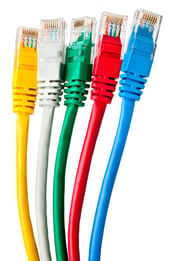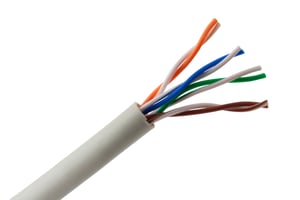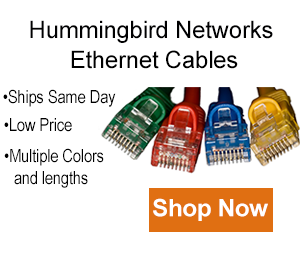
One of the most common questions we get when it comes to Ethernet cables, is what’s the difference between Cat5e, Cat6, and Cat6a cabling? While all three use the same RJ-45 connector ultimately plugging into the same type of Ethernet jack, each option has very different specifications.
Perhaps, the biggest difference between the 3 types is the price. Cat5e is going to be less expensive than Cat6 and Cat 6 is going to be less expensive than Cat6a. You are paying more with Cat6a because of the higher speeds and functionality.
Which type of cable you choose depends on your individual network’s current and future needs. See our breakdown of each type to determine what Ethernet cable is best for your infrastructure.
Difference Between Cat5e, Cat6, and Cat6a
Category 5e high-speed cabling is an enhanced version of legacy category 5 cables but has still been around for over 15 years, making it the most dated. These cables provide Gigabit Ethernet up to 328 feet and are typically made up of 24 guage wire pairs. When they first appeared on the scene, Cat5e cables were the first to deliver 1 Gigabit network speed, which is now the bare minimum you should consider in our opinion. Cat 5e is measured and rated at 100MHz. Essentially, if you are basing most of your network in the cloud than Cat5e might be just fine... for now.
Cat 6
Cat 6 cables have been the standard in cabling for a while now for high-speed gigabit Ethernet networks. They support the high speeds required by the 10G Ethernet standard. However, that support is limited to approximately 164 ft,after that the ultimate speed is the same as Cat5e. The frequency in the Cat6 cables jumps up to 250 MHz making it far superior to the 100 MHz in the Cat5e.
Aside from the increased speed, Cat6 cables have a tighter twist in the cables allowing for two-way communication. The higher standard support has also been known to eliminate some or all crosstalk with other cables.
Cat6A
This is the most recent and one of the most advanced of the Ethernet Cables, which provides the same 10Gbps speed but for a total of 330 feet. Cat 6A cables are an improvement to first generation Category 6 cables, the “A” standing for augmented. These cables deliver lightning fast speeds making them suitable for 10G networks and high bandwidth needs. They also have double the amount of frequency of Cat 6A to a total of up to 500 MHz.
Which One Should You Use?
Most of the time Cat5e is fine for most networks but keep in mind your network is as strong as your weakest link. If you do need faster performance or see yourself needing it in the future your best bet is to invest in Cat 6 to help future-proof your network.
It's What's on the Inside That Counts: Shielded Vs. Unshielded
Shielded Twisted Pair (STP) cables have an extra layer of protection that will help to reduce cross talk and other interference. Typically, the twisted cables have a layer of foil surrounding them inside the PVC jacket. Unshielded Twisted Pair is exactly what you would think, unshielded cables. The twisted pairs don't have anything between them and the PVC jacket as shown. Since STP cables are thicker they don't offer the same flexibility that UTP cables do. If you need a more flexible cable and won't have too many cables in close proximity to one another than UTP would be best. If you think that your cabling will be affected by high interference or you want them to be run inside walls or outdoors than STP will be the right choice.
If you have any questions regarding Ethernet cabling or any other networking needs, please feel free to contact us.










